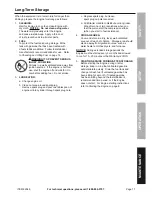
Page 4
For technical questions, please call 1-888-866-5797.
ITEM 62548
Sa
FET
y
SET
up
Op
Era
TiO
n
Main
TE
nan
CE
Operating precautions
1.
CarBOn MOnOXiDE HaZarD
using an engine indoors
Can KiLL yOu in MinuTES.
Engine exhaust contains
carbon monoxide. This is a poison
you cannot see or smell.
NEVER use inside a home or garage,
EVEN IF doors and windows are open.
Only use OUTSIDE and far away from windows,
doors, and vents.
2. Keep children away from the equipment,
especially while it is operating.
3.
To avoid injury, keep hands, fingers, and
feet away from rotating Tines.
Grip the
Handles of the Tiller firmly with both hands. If
both hands are holding the Handles and your
feet are clear of the Tines, your hands, fingers,
and feet cannot be injured by the Tines.
4.
nEVEr till above or near any electrical
cables, gas pipes, or any other utility
lines.
Contact your local utility company
before using the Front Tine Tiller.
4.
DO nOT engage the Forward and reverse
Clutch Levers at the same time.
This
will result in unpredictable Tiller behavior
and possible equipment damage.
5.
Do not use the Front Tine Tiller on steep
inclines.
Use only on level ground surfaces.
6.
Keep a safe distance from the edges
and banks of ditches.
Avoid any actions
that may cause the Tiller to tip over.
7.
if the Tines jam or strike a foreign object,
immediately turn the Engine off.
Wait until the
machine completely stops. Unplug the Spark Plug
cap, remove foreign objects and inspect the Tiller.
Repair any damage found before further use.
8.
Thoroughly inspect the area where the
Front Tine Tiller is to be used.
Beware of possible
buried obstacles such as cable, conduit, irrigation
lines, and landscape fabric. Remove all large
sticks, stones, wires, or other foreign objects.
9. Keep all spectators at least six feet from
the Front Tine Tiller during operation.
10. Fire Hazard! Do not fill fuel tank while engine is
running. Do not operate if gasoline has been spilled.
Clean spilled gasoline before starting engine.
Do not operate near pilot light or open flame.
11. Do not touch engine during use.
Let engine cool down after use.
12. Never store fuel or other flammable
materials near the engine.
13. Only use a suitable means of transport and
lifting devices with sufficient weight bearing
capacity when transporting the equipment.
14. Secure the equipment on transport vehicles to
prevent it from rolling, slipping, and tilting.
15. Industrial applications must follow
OSHA requirements.
16. Do not leave the equipment unattended when it is
running. Turn off the equipment (and remove safety
keys, if available) before leaving the work area.
17. The equipment can produce high noise levels.
Prolonged exposure to noise levels
above 85 dBA is hazardous to hearing.
Wear ear protection when operating the equipment
or when working nearby while it is operating.
18. Wear ANSI-approved safety glasses,
hearing protection, heavy-duty work gloves
and steel-toed boots during use.
19. People with pacemakers should consult their
physician(s) before use. Electromagnetic fields in
close proximity to a heart pacemaker could cause
pacemaker interference or pacemaker failure.
Caution is necessary when near the
engine’s magneto or recoil starter.
20. Use only accessories that are recommended
by Harbor Freight Tools for your model.
Accessories that may be suitable for one
piece of equipment may become hazardous
when used on another piece of equipment.
21. Do not operate in explosive atmospheres,
such as in the presence of flammable
liquids, gases, or dust. Gasoline-powered
engines may ignite the dust or fumes.
22. Stay alert, watch what you are doing and use
common sense when operating this piece of
equipment. Do not use while tired or under the
influence of drugs, alcohol or medication.
23. Do not overreach. Keep proper footing and
balance at all times. This enables better control
of the equipment in unexpected situations.
24. Use this equipment with both hands only.
Using equipment with only one hand
can easily result in loss of control.



















